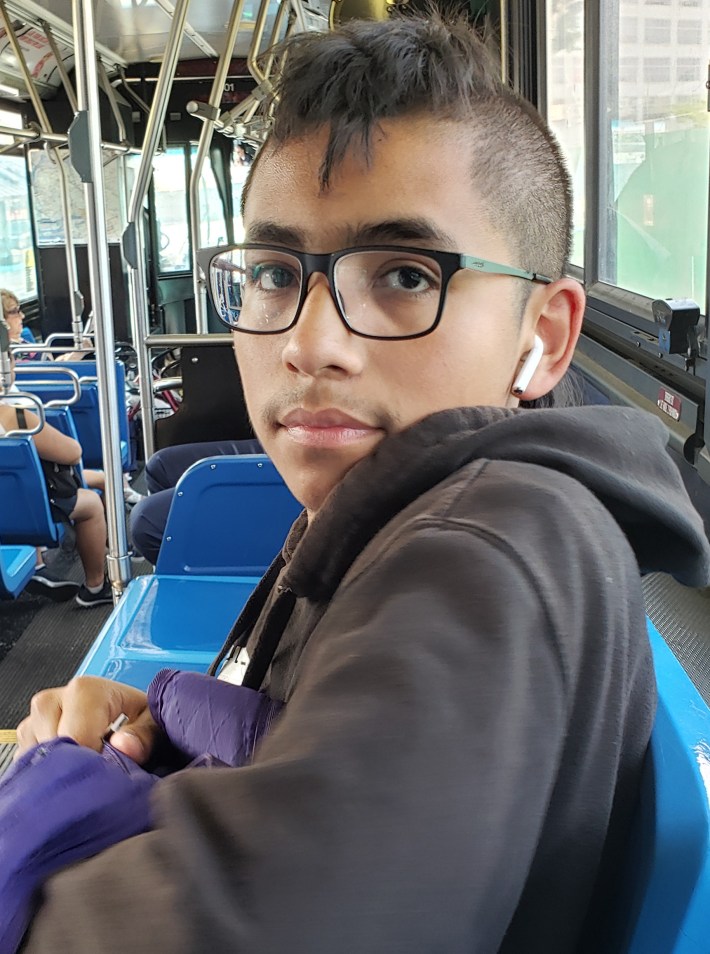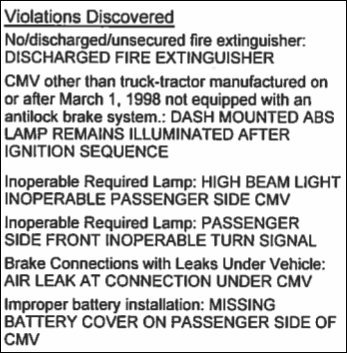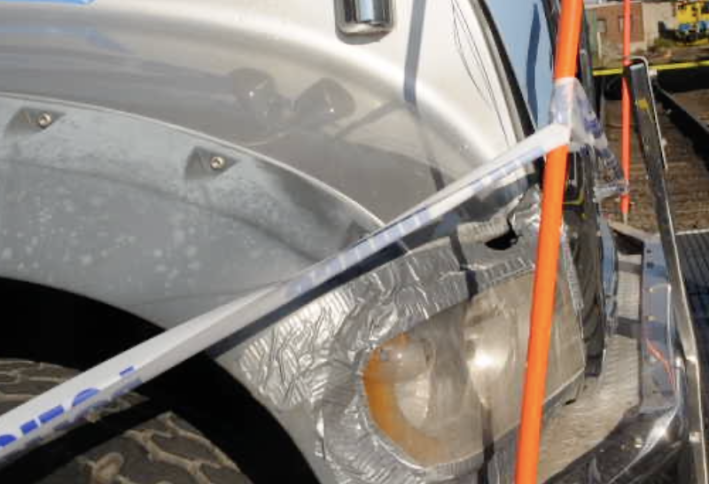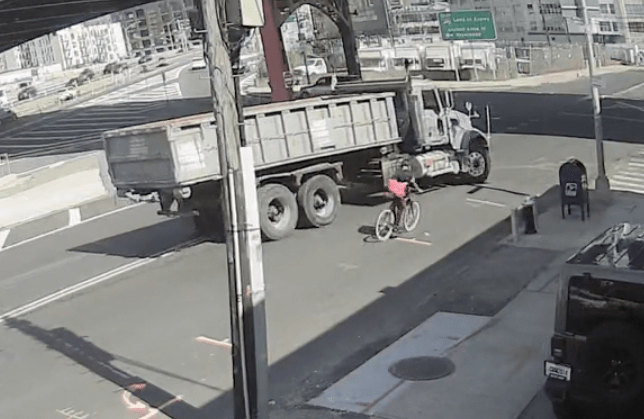A Queens teenager who was run down and killed by a truck driver in 2019 did not cause his own death as the NYPD claimed, and the trucker should have been held responsible for fatally striking the cyclist, said a lawyer for the victim's family, citing a shoddy, victim-blaming investigation by cops.

Mario Valenzuela was killed by driver Tyron Leon on Sept. 21, 2019 at the corner of Borden Avenue and 11th Street in Long Island City when Leon made a typical — and unsafe — truck-driver move: He veered to his left before cutting hard into a right turn, directly into the cycling Valenzuela.
And Leon did not use his turn signal, a video of the incident shows.
Nonetheless, the Collision Investigation Squad blamed Valenzuela for the fatality, claiming he was "unable to stop before colliding with the front right side of vehicle," according to documents obtained under a Freedom of Information Law request by Steve Vaccaro, the Valenzuela family lawyer.
"Mario was victimized twice," Vaccaro said. "He was killed by the truck driver, and then blamed for his own death, despite a mountain of evidence to the contrary."
The evidence to the contrary
Cops were able to obtain surveillance footage of the crash, and two key segments are provided in the CIS file obtained by Vaccaro. The first video, looking westbound on Borden (click here), is relatively unremarkable, showing the Limited Interior Group truck turning (in the very top left corner) from Vernon Boulevard onto Borden Avenue, starting the chain of events. At about :13, the truck truly comes into view, with Valenzuela pedaling behind it. They both leave the frame at :22 and this video is no longer relevant.
The more crucial video (click here — trigger warning) is from the same spot, but looking eastwards on Borden Avenue. From this angle, the truck enters the frame at :20, with Valenzuela a second behind it. One important detail that is never noted in the police report: The truck driver is first seen straddling the roadway's centerline, then it appears to veer to the left, as if Leon intends to turn left into the Long Island Expressway entrance ramp just ahead of him.
Then, without warning or signal, he veers right — cutting off Valenzuela, who had by that time caught up to the truck and was rolling parallel to it. On the video, Valenzuela eventually sees that Leon's move to the left was actually a precursor to his right turn, and Valenzuela instinctively turns away from the truck. But the truck is moving too fast, and Valenzuela does not have time or space to avoid being hit by its front tire, which knocks him off the bike. As the truck leaves the frame, it rolls over Valenzuela, whose friends are seen arriving a few seconds later, reacting in horror.
It is likely that Valenzuela intended to continue straight on Borden Avenue and was thinking that the veering trucker was going to turn left, not right.
What is in the CIS report?
The crash was at 1:54 p.m. on Saturday, Sept. 21. Even before police arrived, a false narrative about the death of Mario Valenzuela was already forming: The 911 log, citing a witness, said that the victim "WAS HOLDING ON TO THE TRUCK WHILE IT WAS TURNING AND HE GOT RAN OVER." The video contradicts that flatly, but it is clear that this narrative informs some of the investigation.
Officers from the 108th Precinct and EMTs arrived quickly. Valenzuela was pronounced dead at 2:02 p.m. Officer Ramon Pina's preliminary investigation determined that "the bicyclist struck the passenger side vehicle, causing him to fall to the roadway." That preliminary report says that Valenzuela was "entering [an] intersection with traffic signal."
But there is no traffic signal at the intersection.
And though it is true that Valenzuela struck the vehicle, it is also true that the vehicle struck Valenzuela, which is not noted in the report.

Cops wrote up Leon for multiple equipment infractions (right), including "passenger side front inoperable turn signal." This is a key fact established in the preliminary investigation.
Collision Investigation Squad Det. James Conlon arrived at 3:20 p.m. and began case number 719-49. Leon was tested for alcohol impairment at 3:50 p.m. The field sobriety test revealed neither alcohol nor drugs.
At around 4:15 p.m., Conlon called two witnesses — both of whom had been in the 911 log — and asked if Leon, the trucker, had signaled for the right turn. Neither witnesses recalled seeing a signal. (Reminder: Leon had been written up by the arriving officers for an "inoperable" passenger side turn signal.
At around 4:30, Conlon received a written statement in Spanish from Leon. In the statement, Leon says he signaled for the turn. Conlon did not challenge that assertion, despite the fact that officers had already summonsed Leon for the broken turn signal.
On Sept. 24, Colon said he received the videos from a business owner on the block. In his report, he claims that the eastward-focused video shows the Mack truck "with its right turn signal." The video does not show that.
On Dec. 31, Conlon again closed the case, concluding, "After reviewing all the information available, it is my opinion that the contributing factor is as follows; BICYCLIST ERROR — Improper Passing."
He again repeated that "the operator activated his right turn signal prior to reaching 11th St." Nonetheless, he did mention the multiple summonses issued to Leon on the day of the crash — including that inoperable turn signal — yet still concluded, "I do not believe [the violations] contributed to the collision."
In the end, Conlon wrote that "the bicyclist was unable to stop before colliding with the front right side of [the] vehicle," which is almost the same language used by the responding officer, who did not have the benefit of the video footage or interviews with witnesses.
How is the CIS report wrong?
CIS investigator Conlon successfully obtained video, but did not use it correctly in his investigation. For instance, the report did not refer to Leon's erratic driving before the crash — he veered far into the westbound lane before lurching quickly to his right, a common move by truckers who do not want to slow down fully to make a right turn. At the very least, it is a failure to exercise due care — indeed, the video shows oncoming traffic that Leon almost hit.
Conlon's report also does not mention the possible left turn ahead of Leon — that LIE entrance ramp — which might have suggested to Valenzuela that Leon was veering left because, indeed, he intended to turn left. Conlon also does not reflect upon the multiple dangers to drivers, pedestrians and cyclists on that stretch of unsignalized roadway, which is popular for truckers who are toll-shopping — an oversight that reveals again that CIS investigations do not inform the Department of Transportation's understanding of roadway design. There does not seem to be a mechanism connecting CIS reports to DOT review and action. (DOT did not return an email seeking comment on this.)
Conlon's report said he interviewed Leon, who claimed he had not been on his cellphone at the time of the crash. But there is no evidence that Conlon sought cellphone records to confirm that.

But most important: Conlon does not mention in the report that a bicyclist traveling on a roadway has the right of way to continue on that roadway. It is the responsibility of the driver, who is turning, to yield to the cyclist, who is not. That is basic motor vehicle law.
"Think of it this way," Vaccaro said. "If there are two cars traveling side-by-side on a road and the car in the right lane wants to continue going straight and the car in the left lane wants to make a right turn, the car in the left lane can't just veer into the other car. It has to yield. The burden is on the motorist to exercise due care. The same burden applies when there's a cyclist, but this CIS detective clearly does not know that.
"Mario was not at fault," Vaccaro continued. "He had the right of way to proceed straight through the intersection. This is one of the worst cases of a windshield perspective twisting a crash analysis that I have ever seen. The detective's unstated — and entirely incorrect — premise appears to be that Mario had no right to bicycle on the right-hand side of the road near the truck. From this misbegotten premise the crash is blamed entirely on Mario, with no consideration of the facts."
Those facts include:
- a driver is required by law to make a right turn from the right side of the lane (Leon had veered left, crossing over the double-yellow line)
- Leon approached the turn at a dangerous speed, which, Vaccaro believes, is why he went left before turning right
- the truck had a broken turn signal on the passenger side.
- the driver would have seen Valenzuela in his passenger-side mirrors, but apparently failed to use those mirrors before turning. Vaccaro sees that as evidence of driver negligence.
"The detective not only ignored this extensive proof," Vaccaro said. "I am mystified as to why the detective would so utterly abandon sound investigative technique, reaching to blame Mario, when it is plain that the driver is 100 percent responsible."
So what happens now?
Two timelines are running in parallel:
- The failure of the police to do a proper investigation that blamed the guilty party — the truck driver — will likely lead to renewed calls for taking the Collision Investigation Squad out of traffic investigations entirely.
"We need to pass a 'Mario's Law' in the city to take traffic enforcement out of the police department," said Vaccaro, citing not just the shoddy post-crash investigation, but the documented racial bias demonstrated by police in routine traffic stops, which advocates say could be much better done by cameras or be obviated by better roadway design.
Vaccaro believes that shoddy CIS investigations, and police victim-blaming, can be "the tip of the spear" to getting police out of traffic enforcement.
"If these are the specialists who are specially trained to deal with the most dangerous collisions, and these are the mistakes they make, it shows the need for reform," he said.
- More immediately, Vaccaro and the Valenzuela family will take the case to the state Department of Motor Vehicles, which will hold a hearing on Nov. 10 to determine if truck driver Leon will lose his license for a short amount of time, a long amount of time, permanently or not at all.
The initial problem is that in a state still ravaged by the coronavirus pandemic, these DMV hearings are conducted by telephone, which means the victim's family is unseen and unheard. And it is unclear if hearing officers are receiving or accepting evidence. Vaccaro said he had a case in September — his first since the end of New York's COVID lockdown — that was flawed because not only did the officer not show up, but the administrative law judge had not received all the evidence, which included pictures and a police report that, at least this time, blamed the driver.
"We ended up getting a three-month suspension in that case, but the fault was so clear," Vaccaro said. "We don't want a repeat of that. If the judge can't see the video and I'm just a voice on the telephone, we've lost. These hearings used to be in-person, and the cop would show up and bring the full file. We need to fix this DMV process so that it's not unfair to families."
Mario's mother, Martha Valenzuela, who remains in what she called a "deep pain" because of her son's death, said she only wants "justice for my son."
"I want everyone to know that it was not my son's fault, like the police said," she told Streetsblog. "At the start, I didn't want to blame anyone. You think, 'It's a terrible accident' because you don't know what happened. But I was stunned at how bad a job the police did.
"The only thing I want is justice," she added. "I don't want this driver to keep his license. He cannot drive anymore. I will feel so bad if he gets it back. He is putting more people in danger. And the police need to do a better job investigating these crashes."
Streetsblog reached out to the NYPD for clarification on the CIS investigation and for comment on Vaccaro and Martha Valenzuela's assertions of shoddiness in the investigation. We asked very specific questions in order to ascertain details of Det. Conlon's training, about CIS practices and missing information from the CIS report. In the interest of transparency, here are those questions:
1. Conlon concluded that the victim was to blame for the crash, though officers did write up the truck driver for having a broken turn signal. Conlon had noted that in his report, but said, "I do not believe [it] contributed to the collision.”
Question: Does the NYPD have a comment about that conclusion?
2. Conlon’s report did not note what is on the video (which is part of the case file), namely that the driver of the truck veered left before turning right in an attempt to make a right turn without having to slow down.
Question: Why did he not note that maneuver?
3. Conlon states that he spoke to the driver, who said he was not on his cellphone at the time of the crash. But the exhaustive case file does not include evidence that NYPD CIS attempted to confirm the driver’s statement by obtaining cellphone records.
Question: Did NYPD attempt to get cellphone records? If so, what did they find? If not, why not?
4. Conlon blamed the bicyclist even though the bicyclist — going eastbound on Borden Avenue — had the right of way over a truck turning right FROM Borden Avenue onto 11th Street.
Question: Does the NYPD train its officers to know that cyclists have the right of way over turning vehicles?
This is the full response we got from NYPD:
"The NYPD conducted a thorough investigation involving this collision and determined there was no criminality," said NYPD Sgt. Jessica McRorie.






